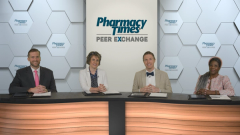
RSV-Associated Impact in Health Care Systems
Drs Bridgeman and Welch highlight cost and resource impacts in health care systems driven by RSV.
Episodes in this series

Ryan Haumschild, PharmD, MS, MBA: When we think about RSV [respiratory syncytial virus], we know it’s really about improving outcomes for the patients, but we also know sometimes there’s a lot of health care resource burden that’s associated with this treatment. And as we think about payer plans, the higher total cost of care if a patient does become inpatient, or if there’s a large spread in an elderly community, think of the burden on the health system. Dr Bridgeman, I’d love for you to characterize that for us further. How does the infection affect health care systems and resources? What does that cost of care look like for an RSV admission?
Mary Bridgeman, PharmD, BCPS, BCGP, FASCP: We have seen that in our hospitals there is a tremendous impact associated with the burden of managing RSV infections and the associated complications that we have talked about. [As well as] tremendous utilization of health care resources. We’ve seen our resources quite honestly stretch during peak activity times for RSV activity in our community. I think that patient influx of individuals presenting to the hospital with moderate or severe disease really can be a tremendous issue in the hospital setting. But usually, that also indicates there’s an influx for all the providers in the community and other areas, urgent care, and demand on community providers as well. So in thinking about some cost estimates, what’s the burden? I did come across one analysis that suggests there’s an incremental difference in the adjusted mean annual cost for individuals with RSV and with non-RSV controls. And again, a higher adjusted mean cost for individuals aged 65 and older is $12,000 to $23,000 compared with those younger, those less than age 65, $2200 to $5300. A tremendous potential difference in cost burden associated with managing RSV and complications as well.
Christina Madison, PharmD, FCCP, AAHIVP: And when you think about people on a fixed income, this could be significantly detrimental to their overall health and wellness and their ability to take care of their chronic medical conditions. Because when you’re looking at this giant health care expense and looking at that with your household expenses, how are you going to pay for rent? How are you going to pay for food? How are you going to pay for transportation? Our elderly in particular are very much impacted by things like this. A lot of people are just 1 health care crisis away from bankruptcy.
Ryan Haumschild, PharmD, MS, MBA:Thinking about the Medicare population and coinsurance, it is a huge out-of-pocket expense and something that we’ve got to be really proactive about. How do we keep them out of the hospital? And even the hospitals, a lot of them have been on diversion. There are so many patients and they’re looking for beds, and you gave a great range. I think it really does that length of strain. If someone has a comorbidity, it may take them a lot longer to recover from that RSV infection, so we want to be [as] proactive as possible.
Mary Bridgeman, PharmD, BCPS, BCGP, FASCP: Or an individual who develops bronchiolitis and necessitates intubation, mechanical, and an ICU [intensive care unit] length of stay, tremendous burden.
Christina Madison, PharmD, FCCP, AAHIVP: And the complications that go along with having an ICU stay and then the rehab after, and then not being able to work. There are so many things that could happen. So again, an ounce of prevention equals a pound of cure.
Adam C. Welch, PharmD, MBA, FAPhA: We’re trying to back up to prevent that bronchiolitis and that pneumonia in the hospital by identifying the people in our pharmacies. The community pharmacies that we see every month who have COPD [chronic obstructive pulmonary disease], heart failure, asthma, advanced age, or immunosuppression, target them for prevention so that we can prevent that bronchiolitis, pneumonia, and ICU and all of those complications down the line.
Transcript edited for clarity.
Newsletter
Stay informed on drug updates, treatment guidelines, and pharmacy practice trends—subscribe to Pharmacy Times for weekly clinical insights.





































































































































































































